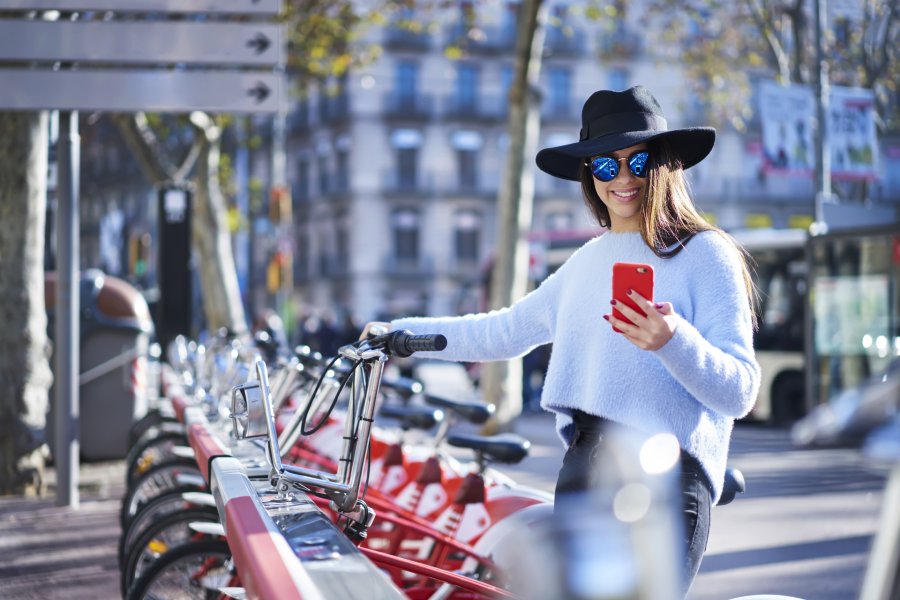Contactless travel isn’t anything new.
Sure, the pandemic fast-tracked the demand for online bookings, tap payments, and mobile customer service. But travelers were already getting used to contactless interactions with travel brands on previous trips, long before the world shut down.
Most airlines launched mobile apps that allowed passengers to buy a ticket, check-in, and scan a digital boarding pass, helping them skip the lines and make their flights on time.
Ride-sharing apps, like Uber or Lyft, made it so travelers could quickly get around a new city without carrying change for public busses or whipping out their credit card in a taxi cab. Even major hubs introduced contactless transit cards with prepaid fares, like the Octopus card in Hong Kong or Oyster card in London.
And many hotels have completely abandoned plastic key cards and instead give their guests mobile room keys that can’t be lost or stolen.
So, how can you get on board with contactless tourism to keep up with travel trends while providing a safe and seamless experience your guests have elsewhere?
Well, you can offer contactless check-in.
What is contactless check-in?
Contactless check-in uses tour and travel software to make it possible for your guests to bypass the front desk and jump right into the adventure. Instead of having to visit your ticket office to sign in, pay, and fill out forms, they can do everything ahead of time through an online booking system and on-site with a mobile app.
Think about your current check-in process. Do guests have to arrive fifteen minutes early to complete paperwork? Do you have line-ups out the door as different groups show up at the same time? Do you have to pass around clipboards or tablets to collect email addresses and other information? Do you only take cash or still use a credit card slip?
If you have a busy lobby and several touchpoints, it can be difficult for your staff to manage social distancing and keep up with disinfecting practices in COVID times. Not to mention, your guests might find it off-putting if they have to use a pen from a public basket, hand over their credit card to pay, or wait outside due to capacity limits, worried they’ll be late and the group will start without them.

With new healthy and safety measures to embrace, contactless technology has swooped in as a solution for tour and activity operators to reduce human interaction and crowding. But even as restrictions loosen, there will still be many benefits to contactless check-in.
It can help you:
- Free up space in your ticket office, making it more welcoming for walk-in bookings
- Keep on schedule and perhaps, squeeze in an extra timeslot with the compounded time you save
- Please guests with a speedy check-in, allowing them to soak up every minute of the experience they paid for
- Minimize administrative work by automatically storing important documents, like liability waivers, online
How does contactless check-in work?
It all starts with an online booking system. Similar to how guests can self-book on a tour operator’s website, they can also sign necessary forms ahead of time and complete check-in steps with a mobile app using the same contactless travel technology.
If you already use booking software, then you might want to check if you can set up the following features to make contactless check-in possible:
1. Guest Forms
A Guest Form is very similar to the booking form in that it allows you to collect essential details but on a per guest basis. After someone completes a booking on your website, they submit each participant’s email address or share the link in a group message. Then, everyone fills out their information privately using the Guest Form.
Part of why you may have guests visit the front desk in the first place is because you need to get names and email addresses from everyone in the group — not just the primary booker. The Guest Form allows you to do that before check-in so that you can send them important booking notifications or add them to your mailing list, too.

But you can also ask for details pertaining to the tour or activity. Since the Guest Form happens after payment, you can ask as many questions as you like (don’t go overboard) because it won’t disrupt the booking flow with too many form fields.
For example, if you run overnight tours, you can ask guests for their dietary restrictions and room preferences. After guests submit their forms, you can see this information in the Daily Manifest, making it easy to prepare detailed itineraries before guests arrive.
2. Digital Waivers
Digital Waivers follow a similar process to the Guest Form. Every booking invoice has a button that the primary booker can click to fill out required documents, whether that’s a liability waiver or rental agreement. And after every guest completes their details, they’ll be prompted to do the same.
Many booking systems integrate with third-party online waiver services, but Checkfront comes with them built-in for Plus and Enterprise plans so that you don’t have to pay an extra fee. Using the Document Editor, you can create an online waiver form and customize it by adding editable fields, like date of birth, signature, and a minor’s section.

When guests sign these documents ahead of time, you will, of course, speed up check-in by eliminating the need to pass around clipboards and chase guests down before the tour or activity starts. But since these documents are safely stored in cloud booking software, you also won’t need your front desk staff to file them as a task going forward.
3. QR Barcodes
Instead of having guests check-in at the front desk, your guides can do it remotely for them using a QR barcode scanner with a mobile booking app. Similar to the Digital Waivers, your guests receive a QR barcode on their booking invoice. All they have to do is open the confirmation email with the invoice for your guides to scan upon arrival.

This contactless travel technology allows you to designate meeting spots outside of your ticket office, whether you want guests to meet in your parking lot, somewhere else on your property with lots of space, like next to your storage shed, so they can check-in at the same time as gearing up, or close to the first stop of a tour.
Not only will this free up space in your lobby and comply with COVID guidelines by gathering outside, but when your meeting spot isn’t limited to a physical location, you also won’t have to account for travel time between point A and point B.
And every minute matters to your guests.
For example, if the first stop of your tour is a fifteen-minute walk from your ticket office, but you start counting down the duration after check-in, your guests lose fifteen minutes of the experience. Whereas if you meet closer to the first attraction, your guests will appreciate the extra time they get to spend seeing what they paid to see.
4. Contactless Payments
Ideally, you might want to collect payment upfront at the time of booking. But since people are still hesitant to book in advance, even with a COVID-refund guarantee, many operators have decided only to take a deposit, if anything at all, meaning that guests have to pay the rest at check-in.
Your guides can use a mobile booking app again to take payments during remote check-in via credit card, gift certificates, or even cash. But you should also have a contactless payment option at the front desk for walk-in bookings and if you sell photo packages, merchandise, or souvenirs.

front desk for walk-in bookings and if you sell photo packages, merchandise, or souvenirs.
So you may want to consider adopting a point of sale (POS) system with a pre-certified card reader, such as Stripe Terminal, which works seamlessly with Checkfront Payments. So, guests can choose if they’d like to pay by swiping, inserting, or contactless tap, whether with a credit card or payment-enabled devices like Apple Pay or Google Pay.
Final thoughts
As always, remember to communicate your contactless check-in process to guests before they arrive so that there’s no confusion.
In your booking confirmation, you can embed the invoice and tell them to save the email and present it to your guides upon check-in at the start of the experience.
And in your booking reminder, you can show them where the meeting location is by embedding a Google Maps image while reminding them again to have their invoice with the QR barcode ready for check-in.
Looking for contactless travel technology?

Take your business to the next level
Online bookings. Flexible pricing. Outstanding support.



